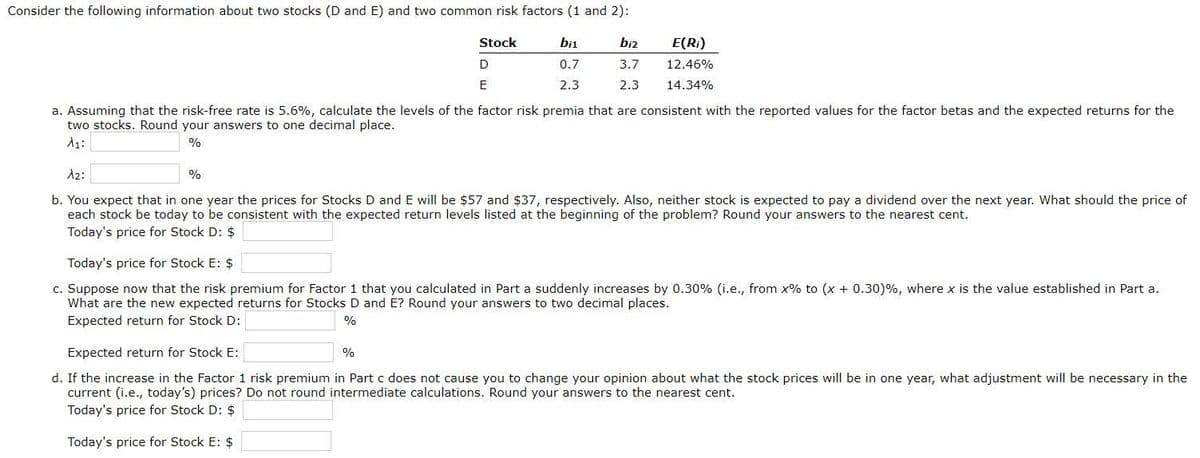Consider the following information about two stocks (D and E) and two common risk factors (1 and 2): Stock bi1 bi2 E(R) D 0.7 3.7 12.46% 2.3 2.3 14.34% a. Assuming that the risk-free rate is 5.6%, calculate the levels of the factor risk premia that are consistent with the reported values for the factor betas and the expected returns for the two stocks. Round your answers to one decimal place. % A2: b. You expect that in one year the prices for Stocks D and E will be $57 and $37, respectively. Also, neither stock is expected to pay a dividend over the next year. What should the price o each stock be today to be consistent with the expected return levels listed at the beginning of the problem? Round your answers to the nearest cent. Today's price for Stock D: $ Today's price for Stock E: $ c. Suppose now that the risk premium for Factor 1 that you calculated in Part a suddenly increases by 0.30% (i.e., from x% to (x + 0.30)%, where x is the value established in Part a. What are the new expected returns for Stocks D and E? Round your answers to two decimal places. Expected return for Stock D: % Expected return for Stock E: d. If the increase in the Factor 1 risk premium in Part c does not cause you to change your opinion about what the stock prices will be in one year, what adjustment will be necessary in th current (i.e., today's) prices? Do not round intermediate calculations. Round your answers to the nearest cent. Today's price for Stock D: $ Today's price for Stock F: $
Consider the following information about two stocks (D and E) and two common risk factors (1 and 2): Stock bi1 bi2 E(R) D 0.7 3.7 12.46% 2.3 2.3 14.34% a. Assuming that the risk-free rate is 5.6%, calculate the levels of the factor risk premia that are consistent with the reported values for the factor betas and the expected returns for the two stocks. Round your answers to one decimal place. % A2: b. You expect that in one year the prices for Stocks D and E will be $57 and $37, respectively. Also, neither stock is expected to pay a dividend over the next year. What should the price o each stock be today to be consistent with the expected return levels listed at the beginning of the problem? Round your answers to the nearest cent. Today's price for Stock D: $ Today's price for Stock E: $ c. Suppose now that the risk premium for Factor 1 that you calculated in Part a suddenly increases by 0.30% (i.e., from x% to (x + 0.30)%, where x is the value established in Part a. What are the new expected returns for Stocks D and E? Round your answers to two decimal places. Expected return for Stock D: % Expected return for Stock E: d. If the increase in the Factor 1 risk premium in Part c does not cause you to change your opinion about what the stock prices will be in one year, what adjustment will be necessary in th current (i.e., today's) prices? Do not round intermediate calculations. Round your answers to the nearest cent. Today's price for Stock D: $ Today's price for Stock F: $
Chapter8: Analysis Of Risk And Return
Section: Chapter Questions
Problem 6P
Related questions
Question
2

Transcribed Image Text:Consider the following information about two stocks (D and E) and two common risk factors (1 and 2):
Stock
bị1
bi2
E(R))
D
0.7
3.7
12.46%
E
2.3
2.3
14.34%
a. Assuming that the risk-free rate is 5.6%, calculate the levels of the factor risk premia that are consistent with the reported values for the factor betas and the expected returns for the
two stocks. Round your answers to one decimal place.
A1:
%
A2:
%
b. You expect that in one year the prices for Stocks D and E will be $57 and $37, respectively. Also, neither stock is expected to pay a dividend over the next year. What should the price of
each stock be today to be consistent with the expected return levels listed at the beginning of the problem? Round your answers to the nearest cent.
Today's price for Stock D: $
Today's price for Stock E: $
c. Suppose now that the risk premium for Factor 1 that you calculated in Part a suddenly increases by 0.30% (i.e., from x% to (x + 0.30)%, where x is the value established in Part a.
What are the new expected returns for Stocks D and E? Round your answers to two decimal places.
Expected return for Stock D:
%
Expected return for Stock E:
%
d. If the increase in the Factor 1 risk premium in Part c does not cause you to change your opinion about what the stock prices will be in one year, what adjustment will be necessary in the
current (i.e., today's) prices? Do not round intermediate calculations. Round your answers to the nearest cent.
Today's price for Stock D: $
Today's price for Stock E: $
Expert Solution
This question has been solved!
Explore an expertly crafted, step-by-step solution for a thorough understanding of key concepts.
This is a popular solution!
Trending now
This is a popular solution!
Step by step
Solved in 6 steps

Knowledge Booster
Learn more about
Need a deep-dive on the concept behind this application? Look no further. Learn more about this topic, finance and related others by exploring similar questions and additional content below.Recommended textbooks for you

EBK CONTEMPORARY FINANCIAL MANAGEMENT
Finance
ISBN:
9781337514835
Author:
MOYER
Publisher:
CENGAGE LEARNING - CONSIGNMENT



EBK CONTEMPORARY FINANCIAL MANAGEMENT
Finance
ISBN:
9781337514835
Author:
MOYER
Publisher:
CENGAGE LEARNING - CONSIGNMENT



Intermediate Financial Management (MindTap Course…
Finance
ISBN:
9781337395083
Author:
Eugene F. Brigham, Phillip R. Daves
Publisher:
Cengage Learning